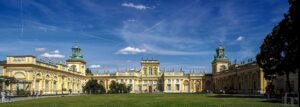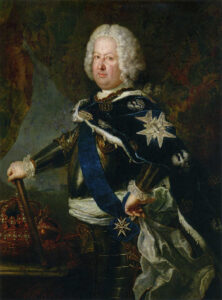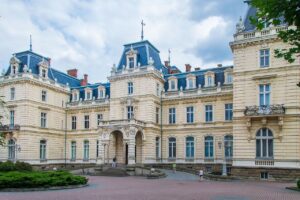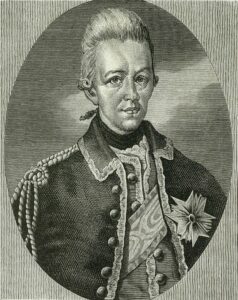The universal tendency to reproduce the model created by the Sun King – also discernible in seats of democratic power, the palaces of the mighty, or the individual microcosms imitating the Bourbon inheritance – cannot obscure the long-standing fascination of the Sarmatian world with Versailles. In many cases, we are dealing with the comprehensive assimilation of patterns radiating from the court of Louis XIV.
by Maciej Forycki
Versailles has been par excellence the most sophisticated model seat of power in Europe in the modern era. In the ingeniously executed plan of Louis XIV, it became the mirror image of his reign. The residence resembles a mirrored maze reflecting and multiplying the perfection of the political model developed. The enormous palace grounds and the adjacent gardens and parks, with the town of Versailles in the background, are laid out in a radial manner from the royal bedroom. From a bird’s eye view, the estate looks like a composition in homage to the Sun King. Likewise, the famous palace apartments, with the Royal Bedroom and the Mirror Gallery at the forefront, reflect the power of the French monarch both in their monumentality, as well as in every detail. The immeasurable gardens indicate the boundlessness of his absolute power, and prove that even nature must be subject to him (this is a French-style garden, subject to the will of man, in which symmetry or geometry rule, and the pruned and modelled plants grow as commanded).
This one-man world was far removed from the peculiarities of the Polish-Lithuanian Commonwealth, in which the political system, state institutions and politics, as well as customs, culture and architecture, were subordinate to the individual. The Polish-Lithuanian state belonged to the nobility, and it was they who were its sovereigns. It was from them, from this very numerous group of self-governing noblemen, that full power stemmed, which is best illustrated by the periods of interregnum, the moment of ‘suspension’ of the functions of the state, and the election of the monarch by the entire (at least in theory) noble nation. This system and its specifics appeared to be extremely distant from the Versailles model.

There were many levels of exchange and dialogue between France and the Commonwealth back then: from grand pan-European political plans or strong dynastic ties, through military cooperation and economic links, to private relations and experiences of travel or trade.
Versailles occupied an important place in these ties because it was its residential arrangements and court organisation that the kings of Poland and powerful magnates used as a model and, on a smaller but common scale, so did the Polish-Lithuanian nobility, as did, in micro-scale references (e.g. through the purchase of products à la française), even the bourgeoisie. What is more, the Versailles influence on the Sarmatian world (and what remained of it, with landed gentry culture at the forefront) was long-lasting: it could be observed until the 20th century.
Versailles in the Sarmatian le Grand Tour style
Numerous representatives of the Polish-Lithuanian noble elites followed Western European models in matters concerning the education of their sons. Following home and school education, the subsequent stage in the formation of a young man was to be a journey across Europe, called le Grand Tour in French.
It usually included the Habsburg dominions, with the unmissable Vienna, the Italian states with requisite Venice, Rome and Florence, a road trip across the Alps (either through Nice and Marseilles, or the Swiss cities), and on towards Paris, and then – sometimes including England and the Netherlands – back home via the states of the German Reich.
Such journeys would last many months, at times even years, as some of the beneficiaries would stay at a college or university along the route, and complete their studies there. In its Sarmatian version, le Grand Tour was very widespread in the Polish-Lithuanian state, especially among the magnates, with fortunes and ambitions, and among the intellectual elite drawing on the West.

The educational peregrination routes obviously included Versailles, which was often the climax of the journey. Echoes of the glory and majesty of Louis XIV reached the Sarmatian elites. After all, the Sun King engaged in lively and multifaceted political exchanges with the Polish-Lithuanian state, which resulted in far-reaching cultural influences. Suffice it to recall that two Polish queens of the time came from France. Equally telling was the adoption of French as an elite means of linguistic communication.
Ceremonials, gardens and mirrors
The enormous French influence on Sarmatian culture must have resulted in the interest, or even fascination, of travellers from distant lands in the East who visited Versailles. The wealthiest of these included the four future kings of Poland, who, before assuming power, had the opportunity to admire the residence of Versailles, but also to observe the way the court functioned, the elements of ceremonials and etiquette, or simply the mechanisms of the court facilities, i.e. the daily activity and organisation of the officials, courtiers, guards, and servants. These observations contributed – in the case of royal travellers, as well as Polish magnates and noblemen – to the transfer of Versailles models to Polish, Lithuanian and Ukrainian territories.
‘Sarmatian Versailles’ reflected the French model – naturally, on a different scale, adapted to the material resources available. In most cases, one can only speak of attempts to imitate or refer to elements of architecture, furnishings or gardens of the residence of Louis XIV. However, in many cases, we are dealing with the comprehensive assimilation of patterns radiating from the court of the Sun King.
In the late 17th and 18th centuries, Old Polish manors liked to boast of the most sophisticated French style. At the royal residences of the Leszczyński family and the Wettin dynasty, linked by alliances with the Bourbons, there was a peculiar cult of copying Versailles models, whether in architecture and art, theatre, ceremonies, or even military practice. Among the wealthiest elites of the nobility, i.e. the magnates, the organisation of court life à la française was desirable, and indicated the aspirations of the wealthy, including the desire to win the Polish crown. Such connoisseurs and imitators of the world of Versailles (and, in time, of the rulers of the Commonwealth) as John III Sobieski or Stanisław Leszczyński, made no secret of this.

Among the best examples of Sarmatian Versailles is the seat of the great and wealthy Potocki family in Radzyń in Podlasie, near Lublin. The palace of Eustachy and Marianna Potocki was built in the years 1746–1766 by Giacomo Fontana, according to a design by Johann Friedrich Knöbel. The architectural assumptions referred to the French model. The residence was built in the Rococo style, with the intention of showing the power of the Potocki family and their monarchical aspirations, and was decorated in the French fashion. An additional clear iconographic message was to emphasise the love and marital fidelity of the owners, Eustachy and Marianna Potocki, whose union gave life to Stanisław Kostka Potocki, a poet, legislator, and politician known in Poland and in Europe.
The idea to erect a residence à la versaillaise stemmed from Eustachy and Marianna Potocki’s close relations with France. In his political activity, Eustachy Potocki was closely linked with the interests of Versailles in the nobility-based Commonwealth: he cooperated closely with the French ambassador in Poland, Charles-François de Broglie. De Broglie, in fact, became, a few years later, head of the ‘secret cabinet’ of Louis XV, the spouse of Marie Leszczyńska, and was one of the main implementers of the Royal Secret – a project aimed at increasing France’s influence in Central and Eastern Europe.
Potocki’s cooperation with Versailles was so close that de Broglie even considered the possibility of France supporting his candidacy for the Polish throne. The magnate’s wife, Marianna née Kątska Potocka, was brought up and educated in the French spirit. She was the daughter of Jan Stanisław Kątski, who translated the epigrams of Jean-Baptiste Rousseau from French, and she herself – an avid reader with a rich library, including numerous French works – translated some of Molière’s plays into Polish.
The Radzyń residence may serve as a model example of a Sarmatian mansion constructed according to the Versailles model. It was built by representatives of the Polish aristocratic and intellectual elite, well acquainted with French culture, who manifested their familiarity through the appropriately designed ceremonial space, architectural scenography, sculpture, paintings, interior decoration, and gardens. The Versailles model also constituted a kind of image trick, showing Potocki as a natural candidate during the future election of the King of Poland.

Polish émigrés in Versailles during the partitions
Versailles also played an important role among Poles in the first half of the 19th century. It was a special place at the time – witness to the greatest flourishing of the Bourbon monarchy and, at the same time, a reminder of the places where the first events of the French Revolution had taken place. Desolate and neglected at the beginning of the 19th century, it reminded contemporaries of Pompeii. Slowly, however, it began to revive and attract a growing number of visitors, including those from lands lying between the Warta, Vistula and Niemen rivers. Since a great gallery of historical paintings was created at the palace in 1837, it became a venue for promoting the history and glory of France, in which great Polish figures also had their share.
Some Poles associated Versailles as the ‘stage’ of Sarmatian Grand Tours, or as a model for magnate residences. The erudite recalled the alliances between the Polish-Lithuanian Commonwealth and France. Versailles itself became a haven for Polish refugees after their country’s partitions, and especially after the fall of the November Uprising, i.e. after 1831.
At that time, Louis XIV’s town was home to around a hundred Polish families, who were active in upholding traditions, providing social assistance to their fellow citizens, and promoting Polish culture through the operation of a Polish library and printing works. Several representatives of this community, who came from the aristocracy, maintained close contacts with the Versailles establishment, including, for example, Antoine IX, Duke of Gramont (1789–1854).

As regards the most monumental realisations of the Versailles compositional system not far removed in time, one can mention – paradoxically! – Nowa Huta, a town near Krakow, built from scratch in the late 1940s as a model socialist realist polis for the workers of the steelworks, which were then named the Lenin Steelworks. Nowa Huta, a city born at the apogee of Stalinism, was built according to all the canons of socialist realism. The central square, named after Joseph Stalin at the time, was planned as a quadrilateral from which the five main arteries of the city radiated. Without interfering in the essence of the Versailles layout, it was adapted to the needs of the new authorities with totalitarian aspirations, establishing a world order according to their own hierarchies.
The universal tendency to reproduce the model created by the Sun King – also discernible in seats of democratic power, the palaces of the mighty, or the individual microcosms imitating the Bourbon inheritance – cannot obscure the long-standing fascination of the Sarmatian world with Versailles. The magnate residences erected at that time were to shine with the power of the families residing in them. They were to be a mirror of the individuality of the nobility, as well as a testimony to thorough knowledge of European cultural models.
Author: Maciej Forycki
Translation: Alicja Rose & Jessica Sirotin





